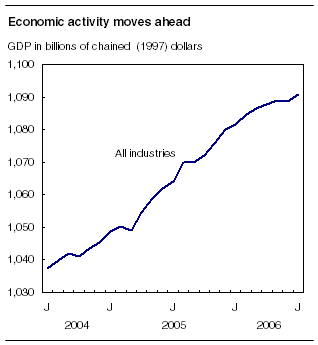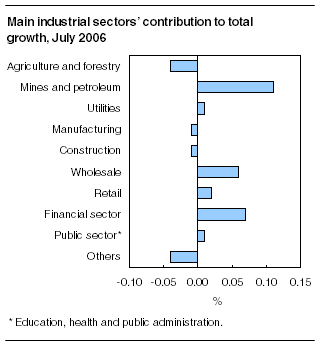Common menu bar links
Gross domestic product by industry
Archived Content
Information identified as archived is provided for reference, research or recordkeeping purposes. It is not subject to the Government of Canada Web Standards and has not been altered or updated since it was archived. Please "contact us" to request a format other than those available.

Economic activity increased 0.2% in July after remaining stable in June. Growth was registered in both goods and service industries. The energy, wholesale trade, retail trade and financial services sectors were especially robust. The construction and forestry sectors declined for a third consecutive month, while manufacturing output was essentially unchanged.

Production rises in energy sector
The energy sector grew 1.3% in July, its first gain since March. Despite the prolonged closure of some sites, oil extraction increased substantially on sites that were operating, both on the East Coast and in the oil sands. Pipeline transportation also posted strong growth. Natural gas production and transportation declined as a result of sizable reserves and weaker prices. For a second consecutive month, oil and gas exploration also recorded a sizable increase following two months of steep declines. Electricity production and natural gas distribution both grew, stimulated in part by increased demand for air conditioning.
Note to readersThe monthly gross domestic product (GDP) by industry data are chained volume estimates with 1997 as their reference year. This means that the estimates for each industry and aggregate are obtained from a chained volume index multiplied by the industry's value added in 1997. For the period 1997 to 2003, the monthly estimates are benchmarked to annually chained Fisher volume indexes of GDP obtained from the constant-price input-output tables. For the period starting with January 2004, the estimates are derived by chaining a fixed-weight Laspeyres volume index to the prior period. The fixed weights are the industry output and input prices of 2003. This makes the monthly GDP by industry estimates more comparable with the expenditure-based GDP data, chained quarterly. Revisions This release of monthly GDP by industry incorporates the revised 2002 and new 2003 input-output annual benchmarks, revised data sources and improved methodologies resulting in revisions to the monthly series back to January 2001. For more information about monthly GDP by industry, see the National Economic Accounts module on our website (/nea). |
The production of the mining sector excluding oil and natural gas advanced 2.4% on the strength of coal and potash, as an agreement was reached with China on potash exports.
Motor vehicle sales boost trade
Wholesale trade grew 1.0% in July. Sales of automotive products and of computers and electronic equipment contributed the most to this increase. On the other hand, reflecting the slowdown in the construction sector, wholesalers of metal, wood, and building products saw their activities slacken. Retail trade advanced 0.4%, benefiting from the return of some incentive programs for the purchase of new vehicles and an increase in used vehicle dealers' sales. Meanwhile, sales of clothing and accessory stores as well as home centres and hardware stores were down from the previous month.

Banking and brokerage activities advance
Activities in the finance and insurance sector grew by a hefty 0.8% in July. Brokerage activity increased due to the higher than normal volume of securities transactions. Banking activities also advanced. In the wake of the previous two months, real estate brokerage services lost ground in July (-1.4%), reflecting the slowdown observed in the existing home resale market.
Manufacturing activity remains stable
Activity in the manufacturing sector remained essentially the same as in June. This sector has been showing signs of weakness since the start of the year. Of the 21 major groups, 10 were up, accounting for 44% of total manufacturing output. The gains were mainly registered in the production of durables, led by machinery, wood and primary metal products manufacturing. The largest declines were recorded in the manufacturing of motor vehicles and parts as well as in plastics and rubber products.
Industrial production (the output of mines, utilities and factories) grew 0.5% in July, led by the strong advance of the mining and oil and gas extraction sector (+1.8%). In the United States, industrial production rose 0.4%, with manufacturing, mining and utilities all showing strength.
Construction sector posts a third monthly decline
For a third consecutive month, the construction sector declined in July (-0.2%), pulled down by a 1.1% drop in residential construction. The drop was especially steep in the construction of single-family homes, while that of apartment units continued to advance. Non-residential building construction fell 0.4%. The drop in the construction of industrial buildings was partly offset by the gain observed in the construction of commercial buildings. Engineering and repair works also advanced, tempering the declines.
Available on CANSIM: tables 379-0017 to 379-0022.
Definitions, data sources and methods: survey number 1301.
The July 2006 issue of Gross Domestic Product by Industry (15-001-XIE, free) will soon be available.
Data on gross domestic product by industry for August will be released on October 31.
For general information or to order data, contact our dissemination agent (1-800-887-IMAD; imad@statcan.gc.ca). To enquire about the concepts, methods or data quality of this release, contact Bernard Lefrançois (613-951-3622), Industry Accounts Division.


 Table(s).
Table(s).